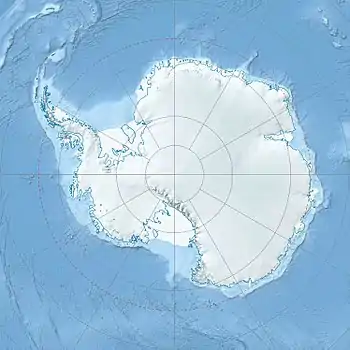Svarthamaren Mountain
Svarthamaren Mountain is a prominent ice-free mountain or large nunatak on the east side of the mouth of Vestreskorve Glacier in the Muhlig-Hofmann Mountains of Queen Maud Land, Antarctica. It was mapped from surveys and aerial photographs by the Norwegian Antarctic Expedition (1956–60) and named Svarthamaren ("black cliff").


Birds
The nunatak supports the largest known seabird colony in Antarctica. Over 250,000 pairs of Antarctic petrels nest there annually, with about 500,000 non-breeding birds also present during the breeding season. Other birds breeding at the site include snow petrels (up to 1000 pairs) and south polar skuas (about 80 pairs). The site is protected under the Antarctic Treaty System as Antarctic Specially Protected Area (ASPA) No.142.[1] The 751 ha site, covering an altitude range of 1600–2100 m, has also been designated an Important Bird Area (IBA) by BirdLife International because of its seabird colonies.[2] During the 2021/2022 breeding season in December and January, extreme snow storm activity led to an almost complete absence of breeding Antarctic petrels, snow petrels and south polar skuas in Svarthamaren Mountain (71° 54’S, 5° 10’ E) and Jutulsessen (72° 3’S, 2°40’E), two of the world’s largest Antarctic petrel colonies.[3]
References
- "Svarthamaren" (PDF). Management Plan for Antarctic Specially Protected Area No. 142: Measure 8, Annex. Antarctic Treaty Secretariat. 2009. Retrieved 2013-01-25.
- "Svarthamaren". BirdLife Data Zone. BirdLife International. 2015. Retrieved 4 December 2020.
- Descamps, Sébastien; Hudson, Stephen; Sulich, Joanna; Wakefield, Ewan; Grémillet, David; Carravieri, Alice; Orskaug, Sebastian; Steen, Harald (2023-03-13). "Extreme snowstorms lead to large-scale seabird breeding failures in Antarctica". Current Biology. 33 (5): R176–R177. doi:10.1016/j.cub.2022.12.055. ISSN 0960-9822. PMID 36917936.
External links
 This article incorporates public domain material from "Svarthamaren Mountain". Geographic Names Information System. United States Geological Survey.
This article incorporates public domain material from "Svarthamaren Mountain". Geographic Names Information System. United States Geological Survey.